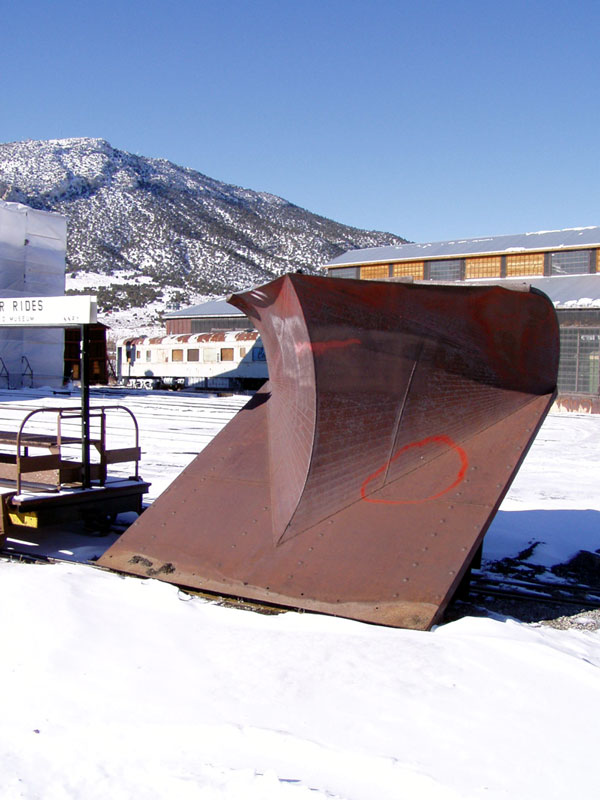The 2005 brochure for the Nevada Northern is now at the printers. The headline for the timetable is “Excursion Schedule—Two Routes—Twice the Fun” and underneath that is the sub headline “Operating Rain, Snow, or Shine.” The reason for this sub headline is that I have received calls from people who were thinking of riding the train but wanted reassurance that the train would operate if there was inclement weather. I assured them that scheduled trains would leave on time. Since this question is asked frequently, I added the sub header to the timetable.
Railroads have been doing battle with the elements since the first train rolled down the track. Heavy rains cause washouts and make the track slippery. Heavy snows can block the track. If that does happen, then the railroad will mobilize all of its resources to get the line open and keep it open.
In the snow-fighting arsenal, the railroads have a variety of resources to call upon. Here at the Nevada Northern the railroad used pilot snowplows, Jordan spreaders, steam shovels, a rotary snowplow, and when all else failed, there was the humble shovel.
A pilot snowplow is a plow that is fastened to the front of the locomotive and is designed to push snow off the track. In the yard, we still have one of the pilot snowplows that was fastened to the front of a steam locomotive. It is a massive piece of steel that goes halfway up the front of the locomotive. The faster a locomotive goes the further the snow is pushed from the track. Of course, if the locomotive derails the further it can go from the track.

Pilot snowplow is about seven feet in height

O.F. Jordan Co., Chicago
Spreader, Flanger, Scraper, Bank Builder, and
Snowplow
Also in the yard is a Jordan spreader. The Nevada Northern purchased this in 1906. The Jordan has a large plow fasten to the front of the unit that can be rotated to push snow to either the right or the left of the track. Along side of the unit are two huge wing plows. These plows can be swung out to push snow farther away from the track. The Jordan spreader is not self-propelled; a locomotive must push it. It has two purposes. During the summer, the Jordan spreader is used to push ballast and dress up the track roadbed. But during the winter, the Jordan spreader actually comes into its own by pushing snow and keeping the line open.
If the snow is really deep, the next tool in the railroad arsenal is the rotary snowplow. The rotary is steam powered but not self-propelled. The steam turns a ten-foot diameter steel wheel that can throw the snow either to the left of the right of the track. When the rotary is sent out, steam locomotives couple onto to it to provide the motive power to push it down the track.
How many locomotives? That depends on how deep the snow is and how quickly the line needs to be opened. I have seen pictures of four, five, and six locomotives tied to the end of a rotary trying to open the line. The last locomotive in the string is always turned around and facing the opposite direction of the rotary. The reason for this is that if the rotary derailed and the other locomotives become bogged down, the last locomotive would be pointing in the direction that they had just come and could hopefully pull the entire mess out. Also, remember that this was before cell phones and radios. So all of these crews communicated with one another with whistle and hand signals. Miss a signal and there could be a disaster.

Cooke Rotary Snowplow “B”
| Finally if all else failed, the railroad would resort to the shovel. The railroad had section gangs. These men were responsible for a stretch of track. Year round, they would inspect the track making sure that the trains could pass over the track. During the warm months, the section gang would replace ties, rails, and spikes as needed. But during the winter, their job was to keep the track open.When all else failed, the section gangs were all brought together and they started shoveling out the track by hand. Today we have specialty fabrics that we wear in the winter to keep us warm. These fabrics are light, waterproof, and warm. None of these fabrics existed back during the heyday of railroading. The section crews wore all of the clothes they could and the fabric was mostly cotton and wool. And if a locomotive derailed then everyone was shoveling. Digging out the railroad was cold, miserable work but it was imperative that the trains ran. Why?In the case of Ely here, the railroad made it possible for the development of the copper mines. The copper mines and the smelter required lots of manpower. This of course attracted many people to live the Ely area. You needed to feed these people and keep them warm. The only way to do this was via the railroad. The railroad brought in the food, medicine, coal, and the mail. If the railroad stopped, then no food came to town; there was no coal for heating and no medicine. Remember, back then, there was no UPS Next Day or FedEx. It was the railroad.Mr. Peterson was one of the last General Managers of the Nevada Northern Railway. I thought I would share with you some of his railroading experiences in the snow. In his autobiography, he talks about keeping the line open during the winter. |
| “We did not have much snow in the winters, but the heavy wind built up big snowdrifts. We also had a (Jordan) spreader at the Nevada Northern and we used it several times to clear the ore line. This spreader had a large snowplow on the front and it would throw snow out 20 or 25 feet if you were moving at our speed limit of 30 mph. The winter of 1949 turned into a big mess. It was called ‘Hay lift’ winter, because the snow was so deep and the drifts so high many sheep and cattle were marooned out in the valleys. We ran special freight trains from Cobre and Shafter to East Ely with 15 or 20 carloads of hay. The hay was unloaded from boxcars onto trucks and taken to the airport, where the bales of hay were loaded into big cargo airplanes, which flew out to the stranded sheep and cattle and dropped the hay out of the plane. At the same time, the highway from East Ely to McGill had snowdrifts 15 or 20 feet high on both sides, where the highway snowplows had built them. In the meantime, we had trouble all along the railroad. In the middle of the night, the dispatcher called me to say we had an ore train stuck in the snow near Hiline (three miles east of Ely). We called out an ore crew and went with two steam locomotives from East Ely until we located the caboose of the train. We hooked on to the caboose and tried to pull the train out of the snow, but nothing moved an inch. So we uncoupled the rear ten cars and were able to get them back to East Ely ore yard. On our next attempt we were only able to pull back three of four cars at a time, then we had to shovel around the locomotive to clear enough snow away from its wheels so we could move it. The snow was at least ten feet deep and in a narrow cut with banks up 20 feet. By this time, the ore trains were far off schedule and the Mill was asking when we would be able to deliver more ore to them. I went with the ore crew and two freight locomotives and started for the mill. The front engine had a fairly large snowplow on the front and we traveled fast, throwing snow high and wide until we got within three miles of the mill. Then we got stuck again in a big cut full of snow. We discovered that the leading engine had become derailed at a switch two miles behind us and we had been running along the top of the frozen ties. If the track had not been frozen we would have torn out a lot of rail. Well, we all got shovels, including the trainmen and enginemen, and dug around all the wheels of the rear locomotive until it was able to back out of the snowdrift. Then we shoveled the track clear until we could couple on to the leading engine. After we dug out all along the inside of the front engine, we were able to move it back, then put down a pair of rerailing frogs and the wheels went back on the rails. What a relief. From there to the mill we made good time. The conductor and I went to the phone and reported we had made it though to the mill and were ready to return.” |
| I have ridden out to Adverse on the front of diesel locomotive during the winter and thought about Mr. Peterson’s experiences getting to the mill. The mill location would have been beyond our current end of track at Adverse. On this particular day we had it easy. The sun was shining, there was no wind, and 204 just plowed through the drifts rather spectacularly but easily. All I had to do was watch. I found it hard to imagine myself battling snow by pushing through the snow as fast as I could, then derailing and digging everything out by hand. Somehow, I can’t imagine calling that the good old days. |
